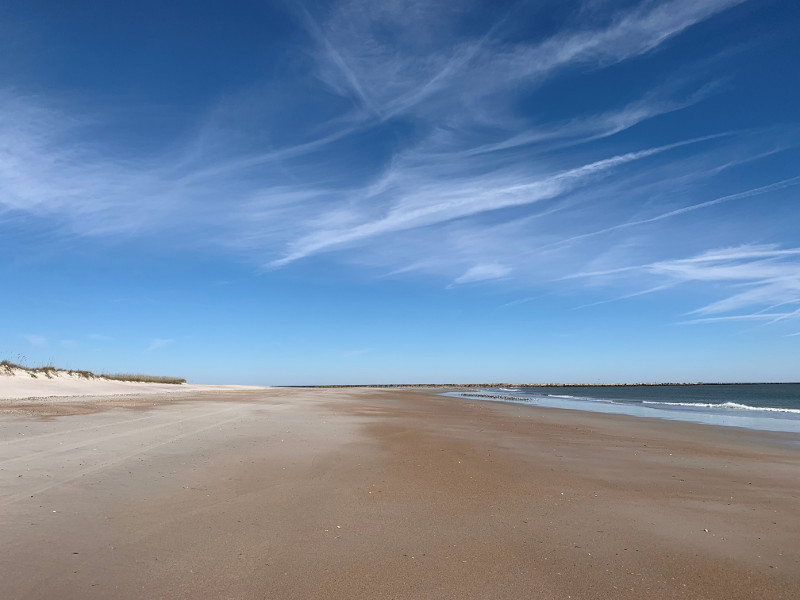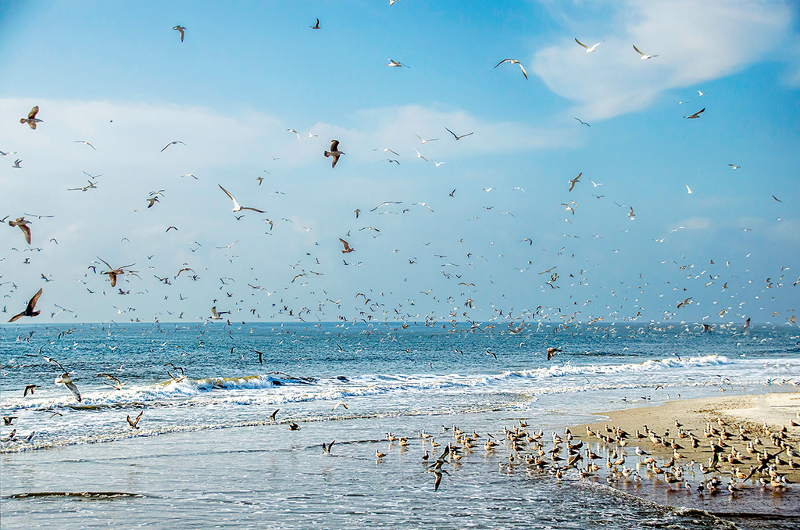
Beaches of Fort Clinch

The beaches of Fort Clinch have everything you would expect of the Atlantic coastline. White sand, strong breezes, gently waving sea oats and beautiful shells abound here. With 0.75 miles of Atlantic shoreline and an additional 2.5 miles along the St. Marys Inlet and Amelia River, there are plenty of opportunities for swimming, surfing, shelling, fishing and viewing wildlife, just to name a few.
However, it is important to remember that this is a wild place - no lifeguards are on duty, and any wildlife you encounter should be left undisturbed in this coastal habitat.

The stretch of Atlantic Beach just south of the jetty provides opportunities for swimming, surfing, sunbathing and surf fishing. Fishing is popular in this area of the park, and depending on the season, redfish, black drum, whiting, flounder, mullet, sheepshead, sea trout and an occasional grouper can be caught.
Shelling is another popular pastime, but one that comes with a lot of responsibility. While it is legal to take fossilized shark teeth and uninhabited shells, doing so requires careful observation and consideration. If the animal inside the shell is still alive, return it to the water. They will appreciate it.
The shoreline near historic Fort Clinch also provides ample opportunities for fishing, shark tooth hunting and wildlife viewing. Bring your binoculars and you might be able to catch a view of the wild horses foraging along the shoreline of Cumberland Island National Seashore which lies directly to the north.
Fishing can be done adjacent to the jetty rocks for redfish, flounder, spotted trout and whiting. Swimming is prohibited in this area due to dangerous currents and steep drop-offs associated with the inlet.

The shoreline just north of the jetty provides for more relaxing activities such as viewing a wide variety of wildlife, including shorebirds, dolphins, and deer foraging in the dunes. Please avoid disturbing resting shorebirds as this causes them to utilize energy that is necessary for their migratory journeys and reduces natural habitat that they can use for resting and nesting activities. Swimming is not permitted north of the jetty due to the dangerous currents of the St. Marys Inlet.
Wildlife found in Fort Clinch State Park can vary widely, from the 800-pound West Indian manatee to the diminutive piping plover. Magnificent frigate birds fly overhead with their trademark red balloon throat pouch and forked tail, while dolphins surface and frolic offshore.
The park is an important resting place and home to several migrating and transient species including the federally threatened red knot (Calidris canutus) and the Caspian, gull-billed and sandwich terns. It is vital that these beaches are maintained as a quiet and peaceful haven for these animals between long journeys.
Several imperiled species are also found and protected within the park, including the shell-mound prickly pear (Opuntia stricta), black skimmer (Rynchops niger), Wilson’s plover (Charadrius wilsonia) and of course the North Atlantic right whale (Eubalaena glacialis), which use the waters off the coast of North Florida and southern Georgia as a breeding ground and nursery for their calves. Loggerhead, leatherback and green seas turtles have all nested on the shores of this island as well.

The beaches of Fort Clinch provide a safe haven for visitors and weary travelers, human and animal alike. If you need to take a break from civilization and the fast pace of life, this is just the place for you.
Everything (and everyone) move at their own speed here, and tranquility is easily found in the beauty of your surroundings. Fort Clinch State Park is truly an experience like no other.